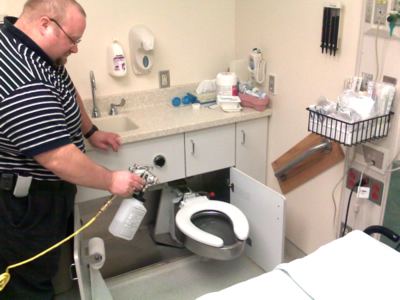 | ||
Non-flammable Alcohol Vapor in Carbon Dioxide systems (NAV-CO2 System) were developed in Japan in the 1990s to sanitize hospitals and ambulances. These systems were developed in response to a need for a safe, effective, environmentally sound way of sanitizing without the use of toxic or corrosive chemicals. The NAV-CO2 method is used to sanitize contact surfaces where individuals may become infected.
Contents
Application
The NAV-CO2 method uses liquid CO2 (carbon dioxide) as a propellant to dispense a 58% isopropyl alcohol solution in a heated stream of carbon dioxide liquid. This technique allows alcohol to be used in an atomized vapor, capable of reaching nooks, crannies, and crevices that would normally be beyond the reach of other disinfecting methods. Alcohol is a wide-spectrum disinfectant that kills bacteria and viruses through denaturation.
Sanitizing solutions
Sanitizing chemicals such as quaternary ammonium compounds can also be added to alcohol-based sanitizers to extend the killing time on surfaces.
Safety of technique
The use of carbon dioxide as a propellant serves to displace ambient oxygen (one of the elements needed to support combustion) and eliminates the risk of explosion. The carbon dioxide and atomized alcohol evaporate completely at room temperature, so no residue remains.
Effectiveness against pathogens
The NAV-CO2 method is used to fight hospital-acquired infections and other pathogens such as:
Alcohol-based solutions have become the leading disinfectant in hospitals in the United States, and are becoming more common worldwide due to convenience of use. Frequent hand washing with alcohol-based solutions is another effective method for the prevention of nosocomial infections.
Advantages
Although resistant pathogens (such as HA-MRSA) are most commonly traced to health care environments, the new community-acquired MRSA (CA-MRSA) strains are now being found in schools, universities, athletic settings, and elsewhere. Hospitals, ambulances, nursing homes, public waiting areas, and food processing plants are just a few of the places that disease-causing bacteria and viruses are known to colonize. Carbon dioxide is a viable alternative to oxidizing sanitizers, such as bleach and other commercial products. Because CO2 is gas at room temperature, liquid alcohol evaporates from any surfaces within minutes of application. Therefore, the surfaces do not require wiping. This reduces the spread of pathogens on cloth and other cleaning materials. Also, alcohol and CO2 are inexpensive and supplies are readily available.
